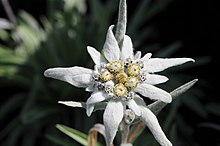| Edelweiss | |
|---|---|

| |
| Scientific classification | |
| Kingdom: | Plantae |
| Clade: | Tracheophytes |
| Clade: | Angiosperms |
| Clade: | Eudicots |
| Clade: | Asterids |
| Order: | Asterales |
| Family: | Asteraceae |
| Genus: | Leontopodium |
| Species: | L. nivale
|
| Binomial name | |
| Leontopodium nivale (Ten.) Huet ex Hand.-Mazz.c
| |
| Synonyms | |
|
Leontopodium alpinum Colm. ex Cass. | |
Leontopodium nivale, commonly called edelweiss (German: Alpen-Edelweiß, English pronunciation /ˈeɪdəlvaɪs/ AY-dəl-vice), is a mountain flower belonging to the daisy or sunflower family Asteraceae. The plant prefers rocky limestone places at about 1,800–3,400 metres (5,900–11,200 ft) altitude. It is a non-toxic plant. Its leaves and flowers are covered with dense hairs, which appear to protect the plant from cold, aridity, and ultraviolet radiation.[1] It is a scarce, short-lived flower found in remote mountain areas and has been used as a symbol for alpinism, for rugged beauty and purity associated with the Alps and Carpathians. It is a national symbol of several countries, specifically Bulgaria[citation needed], Austria, Slovenia, Switzerland, and Italy. In Romania it was declared a "monument of nature" in 1931. The Edelweiss day is celebrated on 5 March. According to folk tradition, giving this flower to a loved one is a promise of dedication.[2]
- ^ Vigneron, Jean Pol; Marie Rassart; Zofia Vértesy; Krisztián Kertész; Michaël Sarrazin; László P. Biró; Damien Ertz; Virginie Lousse (January 2005). "Optical structure and function of the white filamentary hair covering the edelweiss bracts". Physical Review E. 71 (1): 011906. arXiv:0710.2695. Bibcode:2005PhRvE..71a1906V. doi:10.1103/physreve.71.011906. PMID 15697629. S2CID 36857838.
- ^ "5 martie, Ziua florii de colț, declarată monument al naturii încă din 1931". G4Media (in Romanian). 5 March 2023.
